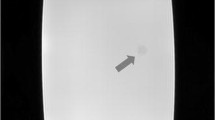Abstract
Signal-detection theory was used to study methods of measuring changes in diagnostic quality from medical image processing. Detectability index and likelihood ratio are applicable for purposes of comparison but they do not give an indication of the confidence with which a diagnosis has been made. Therefore a new measure for evaluation, the diagnostic output, is defined which incorporates this important aspect. This study describes experiments where four observers judge pictures of heart scintigrams in different stages of processing involving variations of resolution and brightness. The emphasis is on methods for evaluation of the diagnostic value of picture processing. Our conclusion is that the influence of the studied image-processing techniques can be well described using signaldetection theory, while the diagnostic output seems to be a well suited measure to represent diagnostic properties of stimulus and observer.
Similar content being viewed by others
References
Buddemeyer, E. U., Bachrach, S. L. andMitchell, T. G. (1979) Instrumentation in nuclear cardiology. InCardiovascular nuclear medicine, C. V.Mosby Co., St. Louis, 3–45.
Eijkman, E. G. J. (1980) Psychophysics. InHandbook of psychonomics I, North-Holland Publ. Co., Amsterdam, 303–363.
Fu, K. S. (1976) Processing of chest X-ray images by computer. InDecision making and medical care North-Holland Publ. Co., Amsterdam, 271–286.
Fu, K. S. (1980) Picture syntax. InLecture notes in computer science. Pictorial information systems, Springer Verlag, Berlin, 104–127.
Eden, G. andGelsema, S. (1979) Investigation of multidimensional data using the interactive pattern analysis system ISPAHAN.Pattern Recognition 11, 391–399.
Gallagher, J. H., Preston, D. F., Robinson, R. G., Herrin, W. F., Servoss, W. andFritz, S. (1977) Image processing and pattern recognition in nuclear medicine.IEEE Trans. on Inf. Processing and Pattern Rec.,55, 55–60.
Gelsema, E. S. andEden, G. (1980) Mapping algorithms in ISPAHAN.Pattern Recognition,12, 127–136.
Goodenough, D. J. (1976) Assessment of image quality of diagnostic imaging system. InMedical images: formation perception and measurement,Hay,G. A. (Ed.), Wiley, New York, 263–277.
Green, D. M. andSwets, J. A. (1966)Signal detection and psychophysics, Wiley, New York.
Grey, D. R. andMorgan, B. J. T. (1972) Some aspects of ROC-curve-fitting: normal and logistic models.J. Math. Psychol.,9, 128–139.
McKelvie, S. J. (1978) Graphic rating scales—How many categories?Br. J. Psychol.,69, 185–202.
Metz, C. E., Goodenough, D. J. andRossmann, K. (1973) Evaluation of receiver operating characteristic curve data in terms of information theory, with applications in radiography.Radiology,109, 297–303.
Metz, C. E., Starr, S. J. andLusted, L. B. (1976) Quantitative evaluation of visual detection performance in medicine: ROC-analysis and determination of diagnostic benefit. InMedical images: formation, perception and measurement.Hay, G. A., (Ed.), Wiley, New York, 220–241.
Nadler, M. (1976) Effective and cost-effective real time picture operators for medical imagery. InDecision making and medical care, North-Holland Publ. Co, Amsterdam, 259–279.
Netravali, A. N. andLimb J. O. (1980) Picture coding: a review.Proc. IEEE,68, 366–406.
Sharp, P. F. (1976) Psychophysical assessment of the penformance of clinical radio-isotope imaging devices. InMedical images: formation perception and measurement.Hay, G. A. (Ed.), Wiley, New York., 242–260.
Sharp, P. F., Chesser, R. B. andSmith, D. B. (1980) Assessment of scintigram quality.IEEE Proc. Part E,127, 185–192.
Simpson, A. J. andFitter, M. J. (1973) What is the best index of detectability?Psychological Bulletin,80, 481–488.
Starr, S. J., Metz, C. E. Lusted, L. B. andGoodenough, D. J. (1975) Visual detection and localisation of radiographic images.Radiology 116, 533–538.
Todd-Pokpopek, A. E. (1976) Image processing in nuclear medicine: an examination of the quest for a measure of clinical quality. InMedical images: formation, perception and measurement.Hay, G. A. (Ed.), Wiley, New York, 278–292.
Author information
Authors and Affiliations
Rights and permissions
About this article
Cite this article
de Valk, J.P.J., Eijkman, E.G.J. & Vintcent, J. Detectability index, likelihood ratio and diagnostic output as psychophysical measures for evaluation of medical image processing. Med. Biol. Eng. Comput. 19, 597–604 (1981). https://doi.org/10.1007/BF02442774
Received:
Issue Date:
DOI: https://doi.org/10.1007/BF02442774




